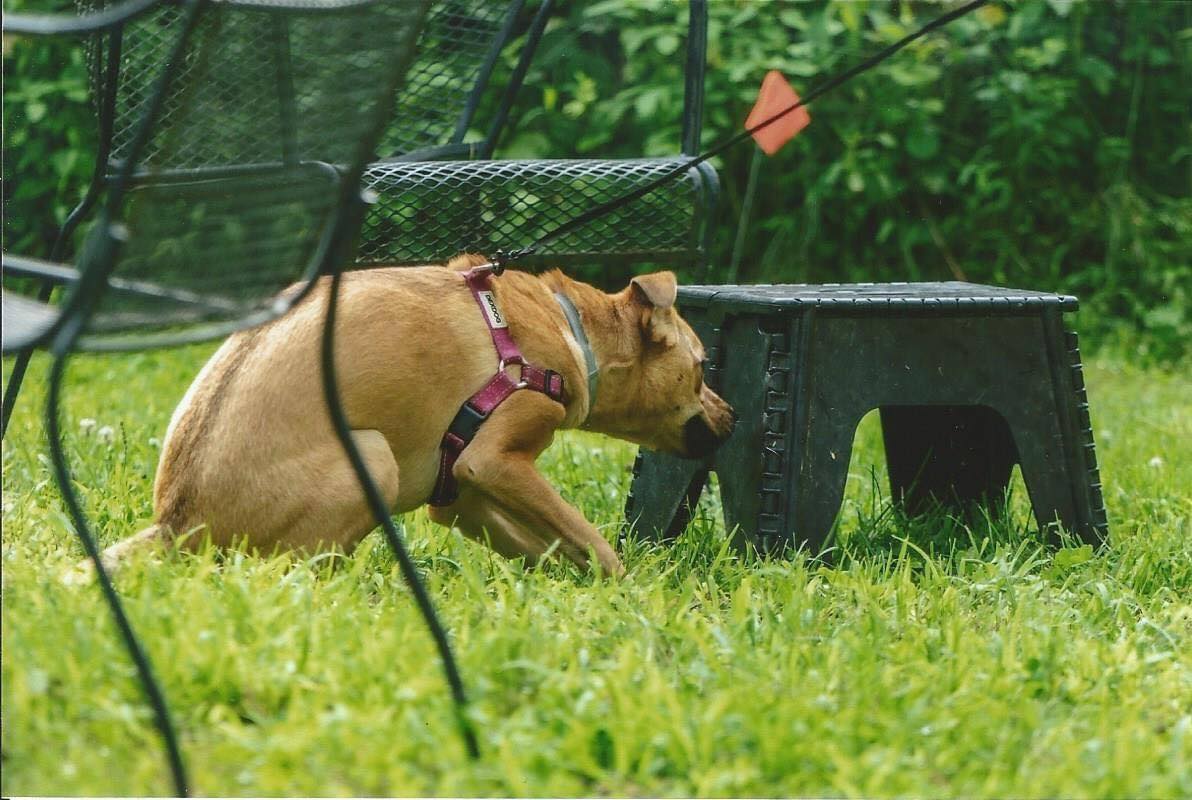One thing every dog knows how to do and loves to do is sniff. Dogs devote over 40 percent more of their brains to smells than we do and have up to 300 million olfactory receptors in their nose compared to the paltry six million we humans have.
That makes sniffing sports and games a natural activity for dogs. It is also an activity that they are exceptionally good at, so they learn easily. Instead of spending your time yelling at your dog for sniffing on his walks, teach him to use his nose. Once my dogs have learned scenting games, they know when they are sniffing and when they need to concentrate on walking and eliminating.
In addition, scent work increases confidence in anxious dogs and can be great for challenging an active dog. Sniffing is hard work – physically and mentally!
Sniffing Games Dogs Play
Tracking is for hard-core trainers willing to face rain, mud, and hot or cold weather as they walk through fields or parking lots laying scent trails for their dogs to follow. And while you might think of tracking as an activity for large hunting or search-and-rescue dogs, it’s something any dog can do. Dogs as tiny as Papillons have earned advanced tracking titles.
The easiest scent games for you and your dog are nosework or scentwork games using essential oils. Most dog sports use a basic set of three – birch, anise, and clove.
Get Started
You can purchase oils and other supplies online. Choose oils that are in common use for competition. There are also online classes if you can’t find one locally.
Start by letting your dog know that a cotton swab scented with the oil is a good thing. The easiest way is to put the swab in one hand (in a tin with a hole so the scent escapes but you don’t get oil on you or the environment) and some tasty treats in your other hand. Then you play a game called “it’s your choice.” Hold both hands out to your dog. When your dog sniffs the tin, bring a treat over from your other hand and reward your dog right at the tin. If he sniffs the food hand, you don’t do anything.
Dogs are amazingly quick to figure out that sniffing the tin turns you into a human treat dispenser. Once your dog reliably indicates the tin you can start to move your hand with the tin; put it behind you, raise it, or lower it. Then you can put the tin on the floor or on a chair so you are no longer holding it. For a dog, this is an easy game of “find the prey” with the prey being the tin and you delivering a treat right at the tin.
Moving on, you now hide the scented tin in another room, then take your dog on leash to find it. Again, this is such a natural behavior that dogs catch on very quickly.
Benefits
Dogs gain confidence doing something they are comfortable with and doing it well. I have taken tins and hidden them at pet stores for my slightly anxious dog. She ignores everything – open containers of biscuits, people, other dogs – in her quest to find that tin! You could easily take a tin to your veterinary appointment (once we get back to normal appointments) and hide one in the exam room while you wait for the technician or veterinarian. Your dog now feels confident, since she found her tin, she gets a great reward, and she has a positive association with the vet clinic. Win/win!
In a real-life example, an adopted dog named Ellie was found as a stray with a broken hip and head trauma, perhaps from being hit by a car. She underwent multiple surgeries and lengthy rehab. When she and her new owner, Lisa, started nose work, Ellie was terrified of walking into new places or approaching strange objects, and passing cars along the road caused her to flatten out in fear. Through the course of their training, Ellie has developed a real love for the game.
“She has been introduced to so many new environments, situations, and people in a positive way,” Lisa says. “I’ve watched her go from a scared, trembling pup approaching the start line to being excited and focused once she caught scent of that familiar odor and started to solve the puzzle. Now things that previously would have sent her into a tailspin she might give a second glance to but shows no real concern. It’s all about the search, figuring out the puzzle and the joy at the end of a job well done!”
This article was reviewed/edited by board-certified veterinary behaviorist Dr. Kenneth Martin and/or veterinary technician specialist in behavior Debbie Martin, LVT.
Deb M. Eldredge, DVM, is a Cornell graduate and the first recipient of the Gentle Doctor Award. She is an award-winning veterinarian and writer.
Photo by Flash Of Paws Photography








